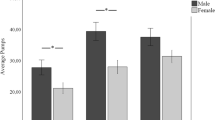Abstract
Fifty-five preschool children were administered a number of tests purported to measure impulsivity: Delay of Gratification, Walk-the-Line-Slowly, Matching Familiar Figures Test, Schenectady Kindergarten Rating Scales, a teacher rating scale, and the Porteus Maze Test. Analyses indicated that impulsivity is multi-dimensional, with age-, sex-, IQ-, and teacher-related types. The results suggested that multiple indices are essential to the measurement and study of impulsivity. An interaction between sex and age of child was also revealed with respect to type and rate of activity. While 3- and 4-year-old girls differ radically from boys in type and rate of motor activity (fine muscle vs. gross muscle), 5-year-olds were virtually identical.
Similar content being viewed by others
References
Bjorklund, D. F., & Butter, E. J. Can cognitive impulsivity be predicted from classroom behavior?Journal of Genetic Psychology, 1973,123, 185–194.
Block, J., Block, J. H., & Harrington, D. M. Some misgivings about the Matching Familiar Figures Test as a measure of reflection-impulsivity.Developmental Psychology, 1974,10, 611–632.
Conrad, W. G., & Tobiessen, J. The development of kindergarten behavior rating scales for the prediction of learning and behavior disorders.Psychology in the Schools, 1970,4, 359–363.
Constantini, A. F., Corsini, D. A., & Davis, J. E. Conceptual tempo, inhibition of movement, and acceleration of movement in 4-, 7-, and 9-year-old children.Perceptual and Motor Skills, 1973,37, 779–784.
Dwyer, C. A. Influence of children's sex role standards on reading and arithmetic achievement.Journal of Educational Psychology, 1974,66, 811–816.
Espenschade, A. S., & Eckert, H. M.Motor development. Columbus, Ohio: Merrill, 1967.
Fagot, B. I., & Patterson, G. R. An in vivo analysis of reinforcing contingencies for sex-role behaviors in the preschool child.Developmental Psychology, 1969,1, 563–568.
Harrison, A., & Nadelman, L. Conceptual tempo and inhibition of movement in black preschool children.Child Development, 1972,43, 657–668.
Kagan, J., Rosman, B. C, Day, D., Albert, J., & Phillips, W. Information processing in the child: Significance of analytic and reflective attitudes.Psychological Monographs, 1964,78 (1, Whole No. 578).
Maccoby, E. E., Dowley, E. M., Hagen, J. W., & Degerman, R. Activity level and intellectual functioning in normal preschool children.Child Development, 1965,36, 761–770.
Messer, S. Reflection-impulsivity: A review.Psychological Bulletin, 1976,83, 1026–1052.
Mischel, W. Preference for delayed reinforcement: An experimental study of a cultural observation.Journal of Abnormal and Social Psychology, 1958,56, 57–61.
Mischel, W., & Metzner, R. Preference for delayed reward as a function of age, intelligence, and length of delay interval.Journal of Abnormal and Social Psychology, 1962,64, 425–431.
Morrison, D. F.Multivariate statistical methods. New York: McGraw-Hill, 1976.
Paulsen, K. Reflection-impulsivity and level of maturity.Journal of Psychology, 1978,99, 109–112.
Porteus, S. D.The maze test and clinical psychology. Palo Alto: Pacific Books, 1959.
Smolensky, J.A guide to child growth and development. Dubuque, Iowa: Kendall/Hunt, 1977.
Tobiessen, J., Duckworth, B., & Conrad, W. G. Relationships between the Schenectady Kindergarten Rating Scales and first grade achievement and adjustment.Psychology in the Schools, 1971,8, 29–36.
Ward, W. C.Disadvantaged children and their first school experience: Development of selfregulatory behaviors (PR-73-18). Princeton, New Jersey: Educational Testing Service, 1973.
Author information
Authors and Affiliations
Rights and permissions
About this article
Cite this article
Paulsen, K., Johnson, M. Impulsivity: A multidimensional concept with developmental aspects. J Abnorm Child Psychol 8, 269–277 (1980). https://doi.org/10.1007/BF00919070
Revised:
Issue Date:
DOI: https://doi.org/10.1007/BF00919070




